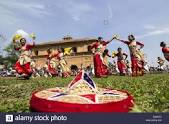Bihu
The main Bihu Festival is grandly celebrated in Assam around mid-April. This festival is celebrated in the spring season with an intention to spread happiness all around. This also marks the arrival of seeding season.

Bihu denotes three different festivals celebrated in Assam . Even though this festival has ancient significance and practices, it has eventually become a very popular urban festival in recent decades. The Bihu Festival involves Bihu folk dance and songs. Bihu is said to be Assam’s national festivals and are considered as a very improtant festival of Assam. The Bihus are celebrated by all the Assamese, irrespective of creed, caste, religion, belief and faith. The people use different instruments during the Bihu Festival called as dhol (drum), toka, xutuli, taal, gogona, pepa (made with buffalo horns) and baanhi (also called as a flute).
Bihu comes from the Dimasa Kacharis language and people, who were agrarian ever since the immemorial time. The meaning of Bi is ‘to ask’ and meaning of Shu is ‘peace and prosperity’. Thus, Bishu became Bihu for accommodating linguistic preferences. They consider their supreme god as Brai or Father Shibrai. During this festival, the season’s first crop is offered to the supreme god and the people wish for prosperity and peace.
Three Bihu Festivals
The celebrations for festival Rongali Bihu begins in mid-April and continues for a month. Other than this, in addition, Assam celebrates two more Bihus – Kongali Bihu, which is celebrated in September or October, and Bhogali Bihu, which is celebrated in January. All these three Bihus are related to farming. In fact, many other festivals are celebrated at the same time all around India.
Rongali Bihu
Rongali Bihu is also popularly known as Bohag Bihu. This festival indicates the beginning of Assamese New Year, which is around April 15 during the spring season. This signals Hindu solar calendar’s first day and New Year is celebrated in various regions such as Bengal, Kerala, Manipur, Orissa, Nepal, Tamil Nadu and Punjab and are called with different names. It is a merry time of feasting for seven long days. The fields are prepared for paddy cultivation and women of the house prepare traditional food called Larus which is made of coconut and rice, Jolpan and pitha which brings in a new charm to the whole season.
In the first day, the cattle is worshipped after washing also called as goru or cow bihu. This is then followed by manuh or human bihu, when people clean themselves and dress in new clothes. Third day after this is indicated as Gosai or Gods bihu. During this time, the Gods’ statues are worshipped and are prayed for a smooth and healthy new year.
Kongali Bihu
Kongali Bihu or Kati-Bihu is celebrated in mid-October. During this time, the field paddy is fully grown. The Farmers’ granaries are almost empty. This Bihu is not celebrated with much or merriment like Rongali Bihu.
Bhogali Bihu
Bhogali Bihu or Magh Bihu takes place during mid-January. This name is derived from Bhog, which means enjoyment and eating. This is known as the harvesting season and marks its end. The granaries are all full this time. All the people feast and eat during this time.
